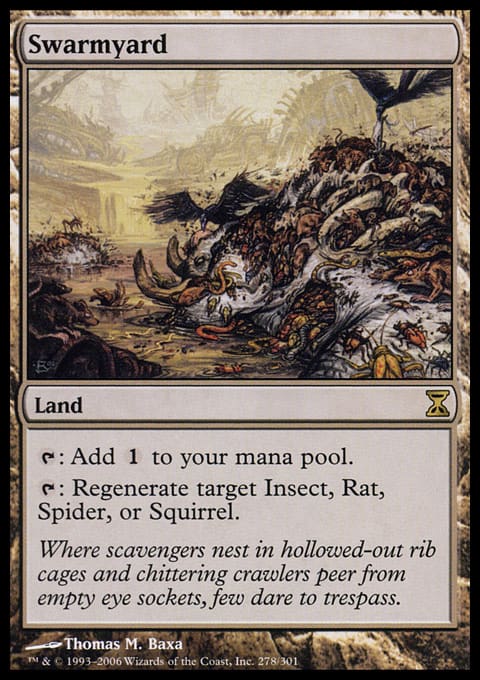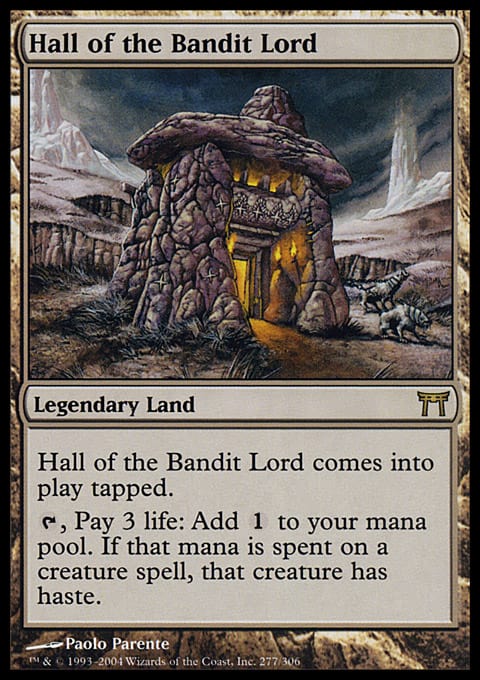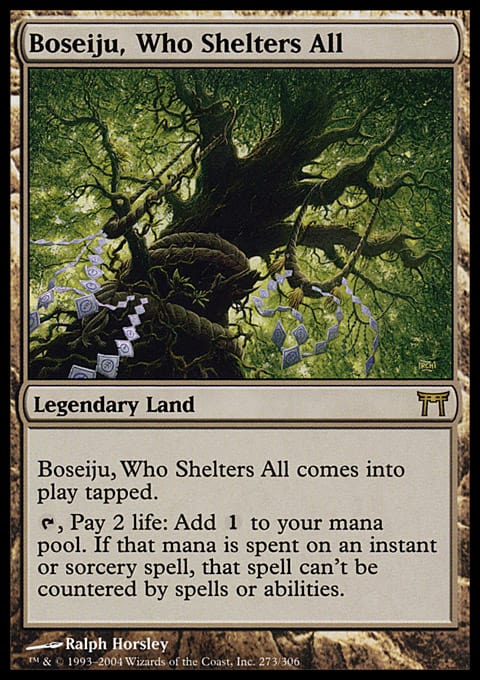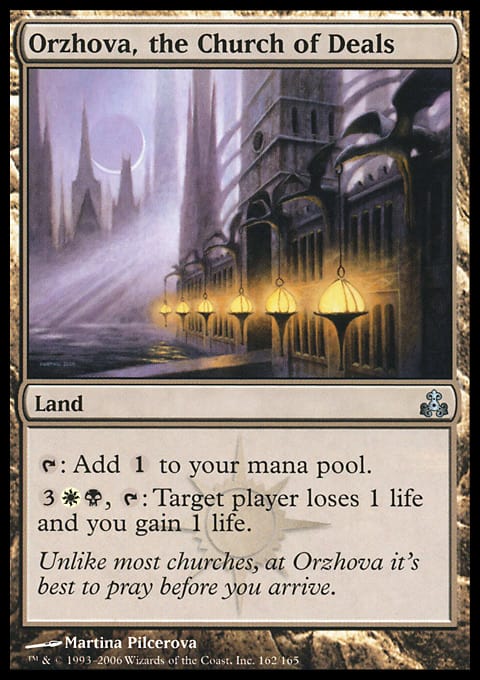“Every Commander Deck Should Run Strip Mine”
I’ve heard this sentiment many times, and it’s easy to see where it comes from. There are a lot of scary lands in Commander—Gaea's Cradle, Cabal Coffers, Academy Ruins—and Strip Mine fits and answer into your deck at the low cost of a single, colorless land. By this logic, it makes sense to throw Strip Mine, Wasteland, and Tectonic Edge in every Commander deck you build.
The problem with this logic is that cards don’t exist in a vacuum. Any card you add to your deck will win you some games and lead to some fun situations. (Divine Intervention is a possible exception.) Deck-building is about choosing the card that will win the most games or provide the most fun.
T: Add  to your mana pool
to your mana pool
You can only run so many lands that tap for colorless in a deck before you start running into mana problems, but there are a ton of great options available. Unless you’re playing Karn, Silver Golem or an Eldrazi as your general, you’re not going to be able to run all the powerful utility lands you have available. Thus, the challenge is figuring out how many colorless-producing lands you can afford to run and then determining which ones best suit that deck’s needs.
How Many Can You Run?
If you need multiple colors of mana early each game, you will have to severely restrict your colorless mana sources. Commanders with heavy color commitments such as Kaalia of the Vast and Glissa the Traitor may want to restrict themselves to only two to three colorless lands. Some decks might not be able to run any at all. For example, many Animar, Soul of Elements decks want to cast Animar on turn two or three and then quickly use him to eliminate colorless costs from the rest of their spells.
A two- or three-colored deck that doesn’t need all its colors immediately can usually run five to six colorless lands without issues. With any more, you start pulling awkward draws with three lands and only a single color of mana.
Mono-colored decks have the most leeway and can safely run up to ten to fifteen colorless lands. However, there are many effects that encourage single-colored decks to run a high number of basics. Gauntlet of Power, Blood Moon, and Emeria, the Sky Ruin are examples of cards that can greatly increase the value of basic lands. When designing a mono-colored deck, you should decide at the outset whether you want to take advantage of a high basic count or use the opportunity to run a large number of utility lands.
So, Which Should I Play?
Fasten your seatbelts, kids; I’m going to barrel through a ton of possible options. I’ll try to keep things brief while hitting the relevant considerations for each category.
Land Destruction
Strip Mine and friends are easily the most widely used. They’re overrated, but I’d never argue that they aren’t good. For the most part, they are largely interchangeable, although Ghost Quarter is a bit too nice for my tastes. Dust Bowl is a bit different, requiring a heavier mana investment, but acting as a bit more of an engine for taking out problem lands. My only warning against it is that it tends to be a bit scarier than the other lands and is more likely to eat a Strip Mine.
Obviously, these are good go-to options for filling out colorless slots, but what determines whether they’re the best answer? It really comes down to what other answers your deck has to problem lands and what other colorless lands your deck would benefit from. Green and red decks often run versatile answers that can deal with threatening lands, such as Acidic Slime and Aftershock, so they may have better uses for utility-land slots. On the other hand, mono-white Voltron is short of answers for both big-mana lands and Maze of Ith and may well want the full suite of land-killers.
The Popular Kids
- Reliquary Tower
- Winding Canyons
- Deserted Temple
- Academy Ruins
- Volrath's Stronghold
- Kor Haven
- Mystifying Maze
In an analysis of over four hundred fifty current Commander decklists on MTGSalvation, more decks contained a Reliquary Tower than contained Islands, Plains, or Mountains. It’s safe to say it’s a pretty popular card. I find myself running the Tower in most of my decks that contain blue, but I would counsel people against running this just because you occasionally draw twenty cards with of a Greater Good or Knollspine Dragon. To be worth the slot, you have to regularly end your turn with eight or more cards in hand and gain a substantial advantage from keeping every card rather than the seven best.
Winding Canyons can be very powerful, allowing mid-combat blockers and dodging Wrath effects. To make it useful, you need a healthy number of creatures and the ability to regularly hit 3 mana on top of whatever you want to be casting that turn. It is at its best in decks that also have powerful instants such as Rout and Blue Sun's Zenith so that you have other things to do when leaving your mana up.
Deserted Temple is especially weird in that it depends not on what type of deck you’re building, but on how many interesting lands you have to untap with it. If you’re using it to untap Boros Garrison or Academy Ruins, you can probably find a better use for the slot. If you are untapping Thawing Glaciers, Cabal Coffers, Gaea's Cradle, and Oran-Rief, the Vastwood, you’re doing it right.
Academy Ruins and Volrath's Stronghold are well known as some of the most powerful lands in the format. Repeatable recursion is very strong when attached to a land, even if it means skipping your draw step. Both recursion lands are valid choices in almost any deck with the right colors—even if you’re just using them to bring back Solemn Simulacrum a few times. I’d try to save them for decks with more high-impact targets, though—they’re at their best recurring powerful threats such as Rune-Scarred Demon and Wurmcoil Engine. Beware the dark side, though—Academy Ruins can be a pretty mean card when it’s recurring things like Mindslaver and Oblivion Stone.
Kor Haven is among my favorite lands for defensive decks with white. 3 mana is not too much to leave up, and a single Kor Haven can often convince multiple potential attackers to look elsewhere. It’s also notable that it doesn’t prevent damage to the attacking creature, so you can still block and kill it. Mystifying Maze is a bit weaker just because of the higher mana investment, but it can fit into any deck. It also has an often-overlooked upside of being able to return stolen creatures and politically trigger enters-the-battlefield abilities.
Tribal
These are obvious in decks built around their tribes of choice, but you may find that you have more valid targets for them than you’d expect. Swarmyard may surprise someone by regenerating a Hornet Queen, Plague Stinger, or Hex Parasite. Contested Cliffs is quite powerful with Felidar Sovereign or Phyrexian Ingester. Most people know about using Riptide Laboratory on Snapcaster Mage, but have you considered using it on Anathemancer or Mangara of Corondor? There are some powerful synergies to be found here if you look for them.
I didn’t list Griffin Canyon and Elephant Graveyard since there really aren’t many playable creatures of those types, but I suppose you could consider them in a changeling-heavy deck.
Don’t Touch My Things!
Homeward Path offers a more powerful answer to theft and Bribery, while High Market and Miren protect your creatures on board and can be used as sac outlets to fuel recursion shenanigans. Homeward Path is better in recursion-light builds in which you’re mainly worried about theft. High Market is the most efficient for defending your creatures against exile, theft, and tuck. Miren, the Moaning Well is a much higher mana investment than High Market, which makes it more difficult to leave up defensively. However, it provides a substantial life boost, which can be useful for decks with that play large creatures without ending the game quickly.
Phyrexian Tower is usually a major improvement over High Market for decks with black in their color identities. The extra mana is usually more relevant than the extra life, and the fact that it’s a mana ability grants it super-split-second. City of Shadows is a little awkward since it doesn’t tap for mana until you exile the first creature, but it can be a useful mana source in token decks while protecting your commander from theft and tuck.
Yavimaya Hollow is a slightly different beast, saving your creatures from destruction instead of theft or exile. It’s not consistently effective given the amount people play exile effects and older card that prevent regeneration, but its stock will rise as we see more playable removal and sweepers without the cannot-be-regenerated clause.
Make a Man out of You
- Blinkmoth Nexus
- Inkmoth Nexus
- Mutavault
- Mishra's Factory
- Dread Statuary
- Zoetic Cavern
- Gargoyle Castle
- Urza's Factory
- Springjack Pasture
- Kher Keep
Creatures are easily the most vulnerable type in Commander, and lands are usually the least, so turning your lands into creatures is not always advisable. The best use I’ve found for true man lands is in Equipment heavy decks—you can get good value out of random 2/2s that ignore Wrath effects. Inkmoth Nexus can be exceptionally deadly with a Sword or two. Gargoyle Castle is a bit different—it’s no great shakes on its own, but it can be a solid token producer with Crucible of Worlds or Life from the Loam.
The repeatable token-producing lands are a bit stronger, but they require enough mana investment that they’re only worth running if you have some particularly good ways of using small creatures—like Skullclamp or Grave Pact. They also have great synergy with Seedborn Muse, allowing you to earn extra mileage out of untap steps without spending cards.
Miscellany
- Terrain Generator
- Scrying Sheets
- Mouth of Ronom
- Rishadan Port
- Mikokoro, Center of the Sea
- Tower of the Magistrate
- Haunted Fengraf
- Petrified Field
- Buried Ruin
Terrain Generator is a pretty sweet card for decks that often leave mana up with cards in hand and then proceed to do nothing. You know: blue decks. Scrying Sheets is a good option for decks with a high basic count that are in desperate need of card advantage. You know: red decks.
Speaking of snow lands, Mouth of Ronom can be a useful option for blue or green decks lacking spot removal. Unlike Scrying Sheets, you don’t need to be running many snow lands for it to be useful—as long as you have one or so to search out, you’re probably okay. The fact that you can find it with Into the North is icing on the cake.
Rishadan Port isn’t very useful as mana denial, but it can be an effective way to disrupt other utility lands. Tapping a Cabal Coffers one turn and a Maze of Ith the next may justify its inclusion.
Players who try to use Mikokoro, Center of the Sea for card advantage are shooting themselves in the foot, but it can be a fun group-hug card if you’re into that sort of thing.
Tower of the Magistrate is one of my favorite techy hidden gems. It just does so many things: It knocks of Equipment, sneaks attackers past chumping Solemn Simulacrums, holds off Wurmcoil Engine, and defends from Duplicant.
The recursion triplets are all functionally similar, but they have very different requirements. Counter-intuitively, Haunted Fengraf is at its best in a deck with a small number of powerful creatures—you want to be bringing back a Consecrated Sphinx, not a Sakura-Tribe Elder. Petrified Field requires you to be playing lands that are powerful enough to be worth destroying and enough nonbasic land search to find them consistently. Buried Ruin is mainly useful in decks with a lot of artifacts that aren’t blue and can’t just run Academy Ruins instead.
You Have How Many Drawbacks?
These two deserve special mention for having no fewer than four drawbacks: They’re legendary, enter the battlefield tapped, only tap for colorless mana, and cost a substantial amount of life each use. Because of that, I am of the opinion that they should barely be counted as lands. Both can be very powerful in the right deck, but you don’t want to be tapping them for Cultivate on turn three and then Acidic Slime on turn four. You want to save them for your Primeval Titan and Genesis Wave, respectively.
Two-Color Goodness
- Prahv, Spires of Order
- Moorland Haunt
- Duskmantle, House of Shadow
- Nephalia Drownyard
- Rix Maadi, Dungeon Palace
- Stensia Bloodhall
- Skarrg, the Rage Pits
- Kessig Wolf Run
- Vitu-Ghazi, the City-Tree
- Gavony Township
- Orzhova, the Church of Deals
- Vault of the Archangel
- Sunhome, Fortress of the Legion
- Nivix, Aerie of the Firemind
- Svogthos, the Restless Tomb
- Grim Backwoods
- Novijen, Heart of Progress
Ravnica and Innistrad each furnished us with a cycle of two-colored utility lands. We’ll have to wait a bit longer to see Innistrad block’s U/R, R/W, and G/U lands, but we can discuss the current batch now.
Prahv is extremely pricey but still worth considering. The facts that it doesn’t target and isn’t limited to creatures mean it can stop anything from Comet Storm to Uril, the Miststalker and make it worth the occasional 7-mana investment. Moorland Haunt is tearing up Standard right now for its ability to cheaply produce spirits. Commander players hate exiling their own creature cards, but 1/1 flyers are useful blockers in a format filled with Dragons.
Duskmantle is quite a bit worse than Nephalia Drownyard. While not terribly powerful in the abstract, they work very well with several of the U/B commanders. Dralnu, Lich Lord and Wrexial, the Risen Deep both love seeing spells hit graveyards, and U/B mill decks are popular with casual players. Rix Maadi is fine in B/R decks that empty their hands quickly (cough, Malfegor) but generally underwhelming. Stensia Bloodhall is not particularly exciting in a 40-life multiplayer format, but the fact that it can hit planeswalkers makes it a bit better than Orzhova.
Kessig Wolf Run is a definite upgrade over Skarrg, but I wouldn’t shy away from playing both with commanders who really want trample. Vitu-Ghazi is a bit pricey for the effect but is playable in token strategies. Gavony Township is significantly stronger, providing a permanent boost that can really add up over the course of a few turns.
Orzhova is pretty much unplayable, but Vault of the Archangel is an absolute beating—it makes your small creatures deadly blockers and your large creatures into a huge source of life-gain. Sunhome is not quite as strong as the Vault, but both make large attackers deadly very quickly. Decks with Dragon commanders want whichever they can run, and Kaalia of the Vast will gleefully run both.
Nivix, Aerie of the Firemind is mind-bogglingly unplayable. Why did they print this? I hop Avacyn Restored will contribute a stronger option.
Svogthos is cute but not terribly exciting. Grim Backwoods is a little too expensive to be a great sac outlet, but drawing cards is never bad, and it will certainly see play in Savra and Ghave decks. Novijen is mostly a bad Oran-Rief, but it can probably still make the cut in Experiment Kraj decks.
Example
I’ve covered some basic theory and listed about sixty options, so I’ll try applying it all to a practical example. Let’s say we’re putting together a Karador, Ghost Chieftain deck and have finally come around to figuring out the mana base.
I’m in three colors, but I’m running a ton of dual lands and green mana-fixing spells, so I have a little bit of flexibility in terms of colorless lands. The first things I want are some sacrifice outlets so that I can reuse creatures like Acidic Slime and Eternal Witness with my commander. High Market, Phyrexian Tower, Grim Backwoods, and Miren, the Moaning Well are all reasonable choices. After a bit of consideration, I decide that I like Phyrexian Tower the most since it doesn’t cost mana to activate, and it sacrifices the creature as a mana ability, allowing us to recast the creature without a window for graveyard hate. I also conclude that since we’re going to be casting spells from our graveyard so often, we’re more likely to need extra life than an additional card, so Miren gets the nod over Grim Backwoods.
We can recur Acidic Slime or Terastodon if we need to deal with scary lands, so we can probably pass on Strip Mine and friends. Reliquary Tower and Volrath's Stronghold don’t seem particularly necessary since our graveyard is our second hand anyways, and we’re not running anything awesome for Deserted Temple to untap. We browse the rest of the list for cards that are good with creatures and come up with Winding Canyons, Gavony Township, and Vault of the Archangel. Kor Haven also seems like a good choice since our slow-but-powerful deck is going to need to fend off some attackers.
This gives us a list of six colorless lands, which seems a little high considering we need all three colors and are also running Temple of the False God. After a bit of consideration, we decide that Gavony Township probably has the lowest impact. Cutting that, we end up with the following selection:
Wrapping Up
I hope this foray into an underexplored area of Commander deck construction has been useful. Take a look at some of your current decks, and see if you’re making the best use of your colorless land slots. And the next time someone tells you that every deck should run Strip Mine, flash out an Avalanche Riders with Winding Canyons, sacrifice it to Phyrexian Tower, and put it back on top of your library with Volrath's Stronghold.
Devon Rule
obsidiandice at gmail dot com . . . and pretty much everywhere else






























